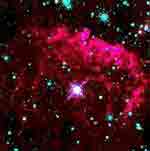|
       
> Star Formation
> Life and Death of a star
> Physical Description
> Star Catalogues
> Classification of Stellar Spectra
> Double Stars
> Variable Stars
> Neutron Star
> Black Holes
    
|
The Sun is a typical
star, with a visible surface called a photosphere, an overlying atmosphere
of hot gases, and above them a more diffuse corona and an outflowing
stream of particles called the solar (stellar) wind. Cooler areas of the
photosphere, which on the Sun are called sunspots, are probably present on
other typical stars; their existence on some large nearby stars has been
inferred by a technique called speckle interferometry . The internal
structure of the Sun and other stars cannot be directly observed, but
studies indicate convection currents and density and temperature that
increase until the core is reached, where thermonuclear reactions take
place. Stars consist mainly of hydrogen and helium, with varying amounts
of heavier elements.
 |
Pistol Star
Astronomers published this infra-red,
digitally enhanced image in October 1997. It is a star located in
the centre of the Milky Way that could be 10 millions times more
brilliant than the Sun. Some scientists claim that the "Pistol
Star", as it is known, is the largest star ever discovered, but
others suggest that the image represents a conglomeration of stars. |
The largest stars known are supergiants with diameters that are more than
400 times that of the Sun, whereas the small stars known as white dwarfs
have diameters that may be only 0.01 times that of the Sun. Giant stars
are usually diffuse, however, and may be only 40 times more massive than
the Sun, whereas white dwarfs are extremely dense and may have masses
about 0.1 times that of the Sun despite their small size. Supermassive
stars 1,000 times as massive as the Sun may exist, and, at the lower
range, hot balls of gases may exist that are too small to initiate nuclear
reactions. An object that may be such a brown dwarf was first observed in
1987, and others have been detected since then.
Star brightness is described in terms of magnitude. The brightest stars
may be as much as 1,000,000 times brighter than the Sun; white dwarfs are
about 1,000 times less bright.
[Back] [Top] [Next] |
